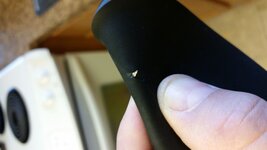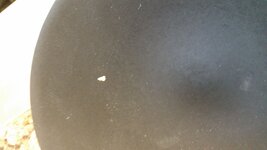kyleoflyman
Jr. Member
- May 12, 2014
- 27
- 10
- Primary Interest:
- All Treasure Hunting
Follow along with the video below to see how to install our site as a web app on your home screen.
Note: This feature may not be available in some browsers.


Possible that elemental nickel is left. I believe the oxidation of the millerite via groundwater is what is causing your green quartz because it is creating nickel oxide which is green. In addition to making nickel oxide it will also create sulfuric acid which will further break down and possibly remove the luster on some of other pieces of the millerite. This process is very similar to when iron sulfide minerals break down and create iron oxide (rust) and sulfuric acid. This will create the rusty looking rocks like this.Thanks for the response! I saw millerite in a book at the library and wondered if that were mineral content I had found. It does lack some of the brassy luster tho, some of the pieces ive collected have a little more silver shine to them. Perhaps thats the nickel coming out?

Assay results came back on the surface samples I sent to get tested. Looks like the green coloring was caused by Nickel. Unfortunately it didnt return very high quantities of gold, less than .005 ppm. Here's some of the results;
Nickel= 1190 ppm
Chromium= 499 ppm
Magnesium= 15.25%
Manganese= 689 ppm
Strontium= 111ppm
Iron= 3.9%
Aluminum = 1900 ppm
Cobalt= 65 ppm
Is it possible for this numbers to increase as I go further into the vein/underground? Guess Im wondering if I should keep on it or move onto another vein.
 I'll do some more investigating to see if I can find a vug or nice crystal structures.
I'll do some more investigating to see if I can find a vug or nice crystal structures.Thanks guys! I think I'll spend another day or two up there when I can.
Ddancer, the nickel came as surprise to me too! Since there was some aluminum content to it as well, I hoped for a higher Beryl count. It came in around .5 ppm. It'd be an exciting chase after some emeraldsI'll do some more investigating to see if I can find a vug or nice crystal structures.
I337scum, thanks for the advice on the numbers. I'll definitely try and find the vein at a lower and higher elevation and do some investigating. While we are talking numbers, what would you say a minimum ppm number for copper would be? I sent in another sample from a different peak in the same range. It came back with 26 ppm. I'll list some more of the occurrences from sample 2 below;
Copper= 26 ppm
Silver= .2 ppm
Aluminum= 1.02 %
Barium= 40 ppm
Strontium= 2370 ppm
Chromium=950 ppm
Iron= 2.75%
Nickel= 1130 ppm
Sulphur= .83%